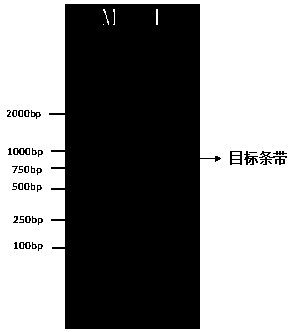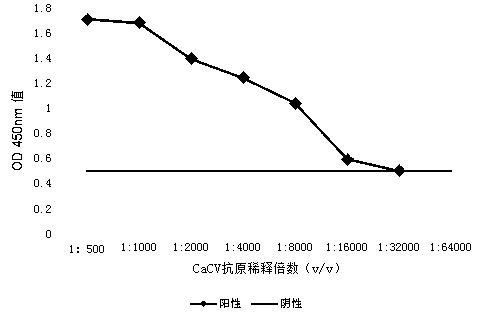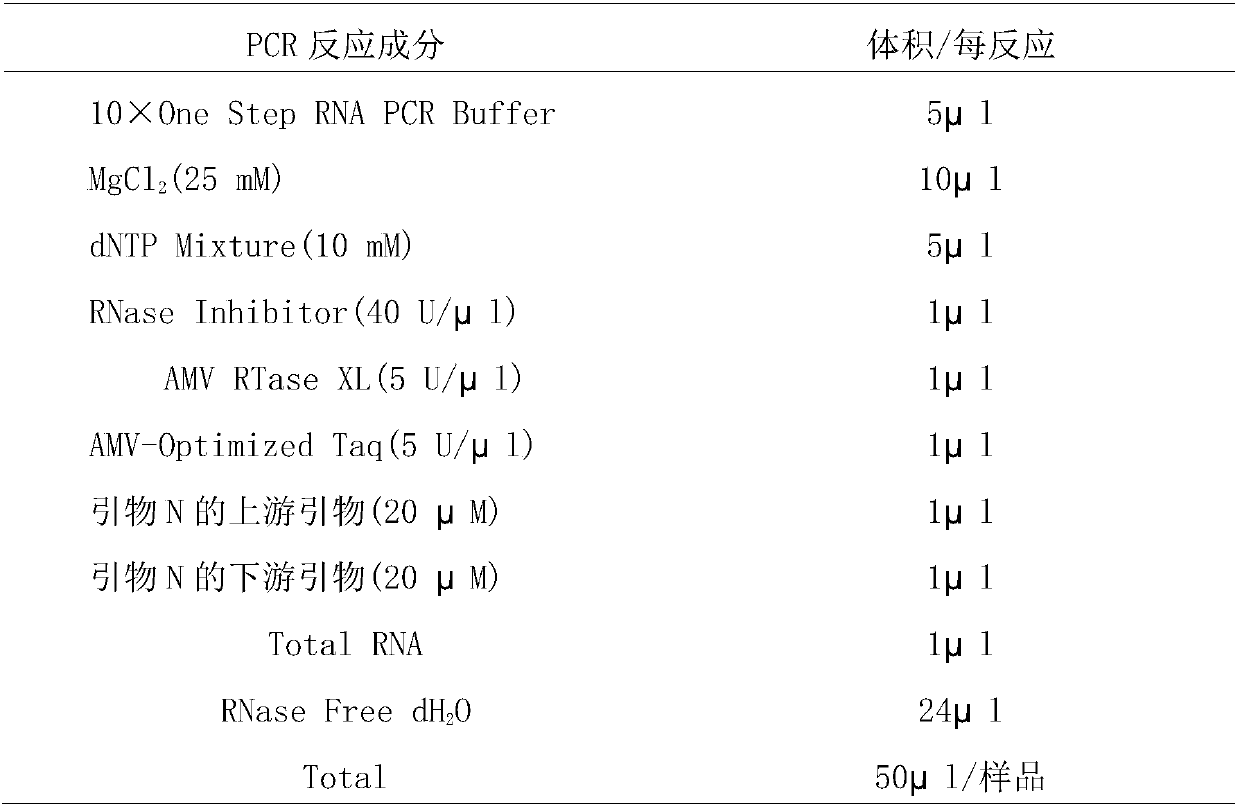Serology method for rapidly detecting capsicum chlorosis virus
A chlorotic virus and serological technology, applied in the field of serological detection of plant viruses, can solve the problems of high cost, long cycle of biological detection, small sample capacity, etc., to eliminate false positives, selectable experimental conditions, and instrument The effect of simple equipment
- Summary
- Abstract
- Description
- Claims
- Application Information
AI Technical Summary
Problems solved by technology
Method used
Image
Examples
Embodiment 1
[0033] Embodiment 1 CaCV NP gene primer design of the present invention and cloning and sequencing of CaCV NP gene
[0034] (1) CaCV NP gene primer design and synthesis
[0035] The CaCV NP gene is based on the complete NP gene in the genome of Capsicum chlorosis virus (CaCV) (accession number: KJ603226.1) reported on NCBI as a template, and Primer 5 is used to design primers, and the primer number is primer N , it is composed of an upstream primer and a downstream primer, the base sequence of the upstream primer of the primer N is shown in SEQ ID NO: 1, the base sequence of the downstream primer of the primer N is shown in SEQ ID NO: 2, The target product fragment length of the primer N is 828bp.
[0036] The above primer N was synthesized by Beijing Qingke Xinye Biotechnology Co., Ltd.
[0037] (2) The acquisition of the CaCV NP gene is carried out according to the following steps:
[0038] ① Synthesizing the primer N described in the above step (1). The primer N was syn...
Embodiment 2
[0058] The preparation of embodiment 2 CaCV NP polyclonal antibody
[0059] Taking the RT-PCR reaction product of the CaCV NP gene obtained in Example 1 as the target gene product, the following experiments were carried out.
[0060] (1) Construction and screening of prokaryotic expression vectors
[0061] In a microcentrifuge tube, take 0.5-4 μl of the target gene product (according to the volume of the target gene product, it can be appropriately increased or decreased, and the maximum is no more than 4 μl), and the pEASY Blunt E1 Expression Kit purchased from Beijing Quanshijin Biotechnology Co., Ltd. was used to make the prokaryotic expression vector Build, see the instruction manual for the specific operation steps.
[0062] After the construction of the prokaryotic expression vector is completed, the bacterial fluid containing the positive recombinant is obtained. Positive recombinants were identified by bacterial liquid PCR. Bacteria solution PCR reaction conditions:...
Embodiment 3
[0078] Embodiment 3 CaCV NP polyclonal antibody sensitivity test of the present invention
[0079] In this experiment, ID-ELISA method was used to detect the sensitivity of CaCV NP polyclonal antibody. The specific experimental process is as follows:
[0080] 1) Coating: Coat the CaCV antigen with 10×PBST buffer, and use the antibody diluent to dilute the CaCV NP protein dilution (that is, the CaCV antigen) at a concentration of 200 μg / ml as described in step (5) of Example 2. Gradient dilution, sequentially diluted to 500 times, 1000 times, 2000 times, 4000 times, 8000 times, 16000 times, 32000 times, 64000 times each CaCV antigen gradient dilution solution, add 100 μl of the above-mentioned each to each well of the microtiter plate in turn CaCV antigen gradient dilution, 4 ℃ overnight or 37 ℃ incubation 2-3h. At the same time, take a healthy spider orchid (Hymenocallis littoralis Salisb.) sample and add 700 μl of pH 7.4 10×PBST buffer to grind, after grinding, centrifuge a...
PUM
| Property | Measurement | Unit |
|---|---|---|
| Molecular weight | aaaaa | aaaaa |
Abstract
Description
Claims
Application Information
 Login to View More
Login to View More - R&D
- Intellectual Property
- Life Sciences
- Materials
- Tech Scout
- Unparalleled Data Quality
- Higher Quality Content
- 60% Fewer Hallucinations
Browse by: Latest US Patents, China's latest patents, Technical Efficacy Thesaurus, Application Domain, Technology Topic, Popular Technical Reports.
© 2025 PatSnap. All rights reserved.Legal|Privacy policy|Modern Slavery Act Transparency Statement|Sitemap|About US| Contact US: help@patsnap.com



